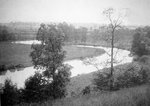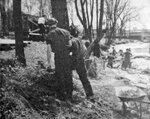



Bucks County’s largest municipal park is the 122-acre Lake Lenape Park connecting Perkasie and Sellersville. However, the park almost did not come to pass until local leaders joined with federal and county officials in 1935 to create a gift to “the children of the future,” as one leader called it.
David D. Cressman, of Sellersville, and Bucks County Works Progress Administration (or WPA) chief engineer William Wilhelm were the primary visionaries behind the Lake Lenape Park project. Records recently discovered in Perkasie Borough’s archives show Wilhelm and the WPA championed the park project, and asked for the iconic twin Roebling suspension bridges to be installed over the creek that runs through the park today.
The WPA was a big factor in Perkasie and Sellersville between 1935 and 1941 since it financed streets, sidewalks, parks, and even zoning laws during the Great Depression. In 1939 alone, the WPA employed more than 1,000 people in Bucks County.
Cressman had advocated for the restoration of the original Lake Lenape in Sellersville in 1930. In the 1890s, the owners of the old Menlo Amusement Park in Perkasie used a rudimentary dam to create a small lake used for boating, fishing and ice skating. By 1930, the dam deteriorated, and the former “lake” was a muddy, narrow stream.
Cressman, Sellersville’s Parkway Commission, and the Branch Valley Fish and Game Association sought local and county funding to put in a new dam on the portion of the park in Sellersville.
The project’s key moment came in October 1935 when Perkasie Borough agreed to join the effort. The East Branch of the Perkiomen Creek’s entire run from Walnut Street in Perkasie to the Bethlehem Pike in Sellersville would now be called “Lake Lenape.” Sellersville contributed 22 acres to the park, while Perkasie and the Bucks County commissioners bought the 30-acre lower section of Menlo Park from its owner, Henry Wilson.
Perkasie’s part of the project cost $122,000, with 95% of that coming from labor paid for by the WPA. Perkasie’s Electric Department paid for the materials needed for the project.
Sellersville’s portion would cost $68,000. Most of the park’s expenses came from installing a new dam, dredging and straightening the creek, planting trees, building boat launches, and removing landfill. Between 70 and 140 workers were used at various times, at a rate of $2 an hour, for the manual labor. The workers came from the WPA rolls of the local unemployed.
In March 1936, WPA engineer Wilhelm began supervising the construction of a new dam in Sellersville. An issue that complicated the plan was the disposition of floodwaters. The solution was the innovative use of landfill dirt to create an artificial island in the creek on Perkasie’s side of the project.
In August 1936, Perkasie Borough approved the idea of a footbridge that incorporated the island as part of the bridge. The WPA presented a plan with two bridges that linked the island, with towers and cabling that resembled the famed suspension bridges of John A. Roebling & Sons of New Jersey.
At the time, Roebling & Sons was also working on the Golden Gate Bridge project in California. The project was approved quickly.
In April 1937, Perkasie Borough advertised for contractors with requirements the suspension system had to meet Roebling’s specifications. The only company that bid on the project was Roebling, at an approximate cost of $2,000. The total bridge project cost was about $6,500 for all materials, including concrete, crushed stone and lumber bought from Perkasie businesses.
The new lake and the bridges were in public use about one month before the park’s official dedication on Sept. 11, 1937. Two weeks before the ceremony the “lake” was stocked with 1,200 largemouth and smallmouth bass. The park’s opening was hailed as a major moment in local history. State deputy attorney general Edmund Kirby was the honored guest. “This is a purely humanitarian project,” he said. “It is placed here with the hope that it will bring many pleasant days to children of the future in return for the efforts put forth in its construction. … It is placed here for the good of all,” Kirby said.
Over time, the scope and nature of Lake Lenape Park have changed. The biggest change was the acquisition in 1956 of 44 acres used to add ball fields and then the relocation of the South Perkasie covered bridge in 1958. Sellersville added its Veterans Memorial in 1983, and new trails were added on a former trolley right of way. Perkasie recently added an outdoor amphitheater in 2022. Still, the heart and soul of Lake Lenape Park is the parkway and trail system added in 1937.
On May 27, 2015, the Pennsylvania State Historical and Museum Commission determined that Lake Lenape Park was eligible for the National Register of Historic Places.
Earning an official listing as a National Historic District would require a joint effort between Perkasie and Sellersville.
Time will tell if that happens, but it wouldn’t be the first time the two boroughs acted together “for the good of all.”
Scott Bomboy is the chair of Perkasie Council’s Historical Committee, and he has written two books about Perkasie’s history.
“Heralding Our History” is a weekly feature. Each month, the Herald delves into the history of one of its towns.
Join our readers whose generous donations are making it possible for you to read our news coverage. Help keep local journalism alive and our community strong. Donate today.